Factors Influencing Psychological Adjustment: Statistics Assignment
VerifiedAdded on 2020/04/15
|54
|9447
|45
Homework Assignment
AI Summary
This statistics assignment analyzes survey data collected from Graduate Diploma in Educational Psychology students in Melbourne, Australia, focusing on factors impacting their psychological adjustment and wellbeing. The study utilized various validated scales, including measures of self-esteem, optimism, perceived control, perceived stress, positive and negative affect, and life satisfaction. A Likert scale was also employed to assess social desirability bias. The assignment presents a case processing summary and an agglomeration schedule derived from the data, likely utilizing cluster analysis to identify patterns and relationships within the survey responses. The analysis provides a detailed breakdown of the statistical procedures and outcomes, offering valuable insights into the psychological profiles of the student population and the factors that contribute to their overall wellbeing. The assignment offers valuable information for students studying statistics or psychology.
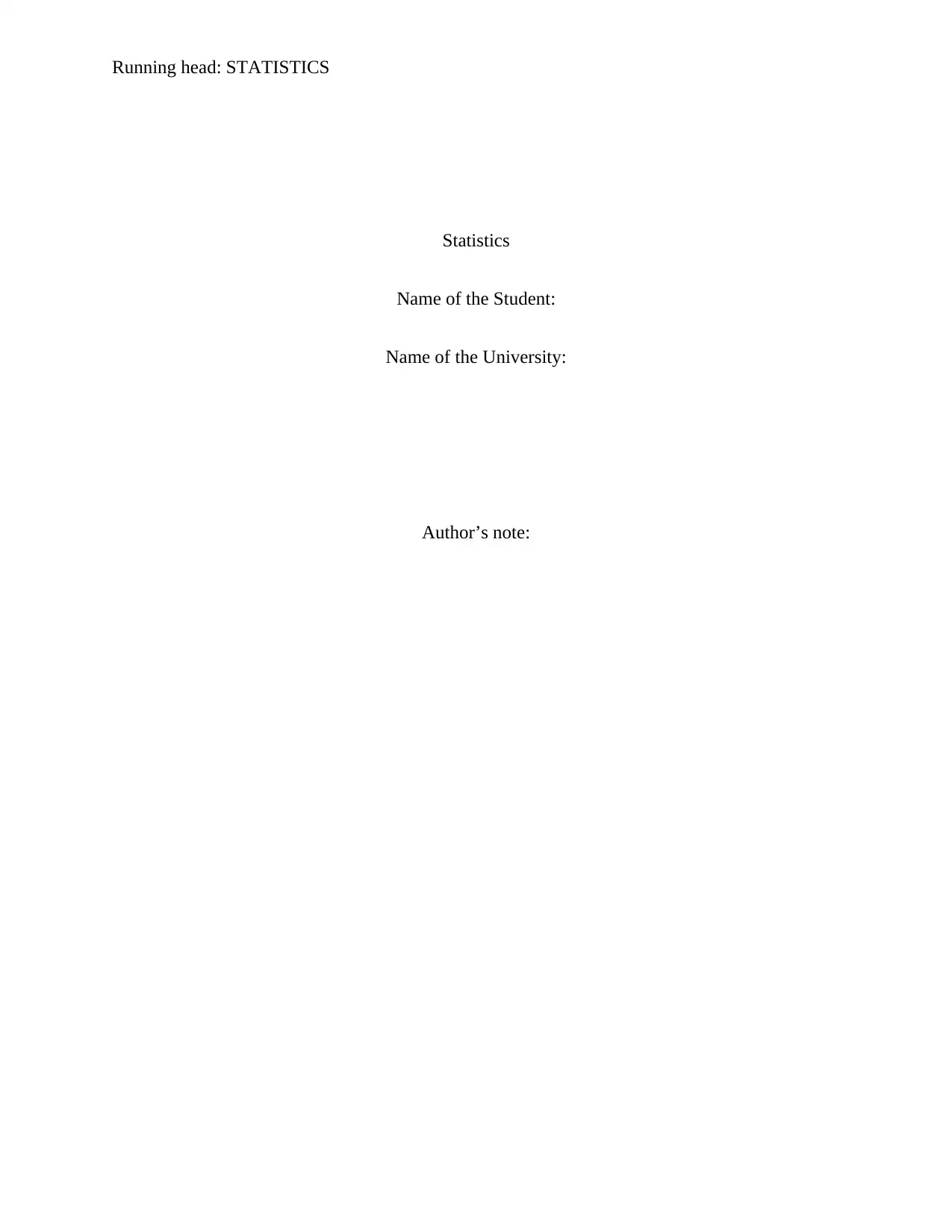
Running head: STATISTICS
Statistics
Name of the Student:
Name of the University:
Author’s note:
Statistics
Name of the Student:
Name of the University:
Author’s note:
Paraphrase This Document
Need a fresh take? Get an instant paraphrase of this document with our AI Paraphraser

1STATISTICS
Table of Contents
Introduction:-...................................................................................................................................3
Question and Answers:-...................................................................................................................3
Answer 1......................................................................................................................................3
Part I.........................................................................................................................................3
Part II.......................................................................................................................................3
Part III......................................................................................................................................3
Answer 2......................................................................................................................................4
Part I.........................................................................................................................................4
Part II.......................................................................................................................................4
Part III......................................................................................................................................4
Answer 3......................................................................................................................................4
Part I.........................................................................................................................................4
Part II.......................................................................................................................................5
Part III......................................................................................................................................5
Answer 4......................................................................................................................................5
Table of Contents
Introduction:-...................................................................................................................................3
Question and Answers:-...................................................................................................................3
Answer 1......................................................................................................................................3
Part I.........................................................................................................................................3
Part II.......................................................................................................................................3
Part III......................................................................................................................................3
Answer 2......................................................................................................................................4
Part I.........................................................................................................................................4
Part II.......................................................................................................................................4
Part III......................................................................................................................................4
Answer 3......................................................................................................................................4
Part I.........................................................................................................................................4
Part II.......................................................................................................................................5
Part III......................................................................................................................................5
Answer 4......................................................................................................................................5

2STATISTICS
⊘ This is a preview!⊘
Do you want full access?
Subscribe today to unlock all pages.

Trusted by 1+ million students worldwide
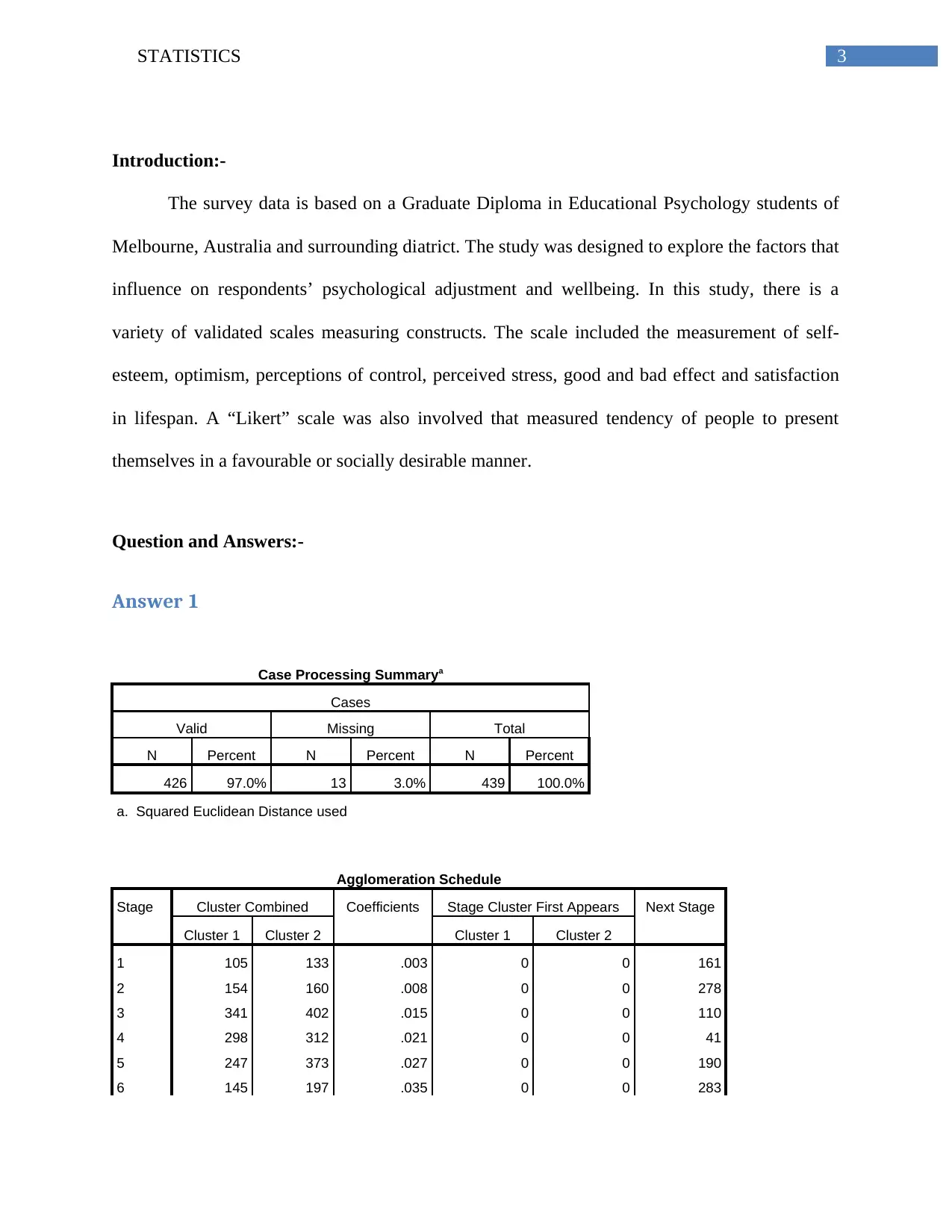
3STATISTICS
Introduction:-
The survey data is based on a Graduate Diploma in Educational Psychology students of
Melbourne, Australia and surrounding diatrict. The study was designed to explore the factors that
influence on respondents’ psychological adjustment and wellbeing. In this study, there is a
variety of validated scales measuring constructs. The scale included the measurement of self-
esteem, optimism, perceptions of control, perceived stress, good and bad effect and satisfaction
in lifespan. A “Likert” scale was also involved that measured tendency of people to present
themselves in a favourable or socially desirable manner.
Question and Answers:-
Answer 1
Case Processing Summarya
Cases
Valid Missing Total
N Percent N Percent N Percent
426 97.0% 13 3.0% 439 100.0%
a. Squared Euclidean Distance used
Agglomeration Schedule
Stage Cluster Combined Coefficients Stage Cluster First Appears Next Stage
Cluster 1 Cluster 2 Cluster 1 Cluster 2
1 105 133 .003 0 0 161
2 154 160 .008 0 0 278
3 341 402 .015 0 0 110
4 298 312 .021 0 0 41
5 247 373 .027 0 0 190
6 145 197 .035 0 0 283
Introduction:-
The survey data is based on a Graduate Diploma in Educational Psychology students of
Melbourne, Australia and surrounding diatrict. The study was designed to explore the factors that
influence on respondents’ psychological adjustment and wellbeing. In this study, there is a
variety of validated scales measuring constructs. The scale included the measurement of self-
esteem, optimism, perceptions of control, perceived stress, good and bad effect and satisfaction
in lifespan. A “Likert” scale was also involved that measured tendency of people to present
themselves in a favourable or socially desirable manner.
Question and Answers:-
Answer 1
Case Processing Summarya
Cases
Valid Missing Total
N Percent N Percent N Percent
426 97.0% 13 3.0% 439 100.0%
a. Squared Euclidean Distance used
Agglomeration Schedule
Stage Cluster Combined Coefficients Stage Cluster First Appears Next Stage
Cluster 1 Cluster 2 Cluster 1 Cluster 2
1 105 133 .003 0 0 161
2 154 160 .008 0 0 278
3 341 402 .015 0 0 110
4 298 312 .021 0 0 41
5 247 373 .027 0 0 190
6 145 197 .035 0 0 283
Paraphrase This Document
Need a fresh take? Get an instant paraphrase of this document with our AI Paraphraser
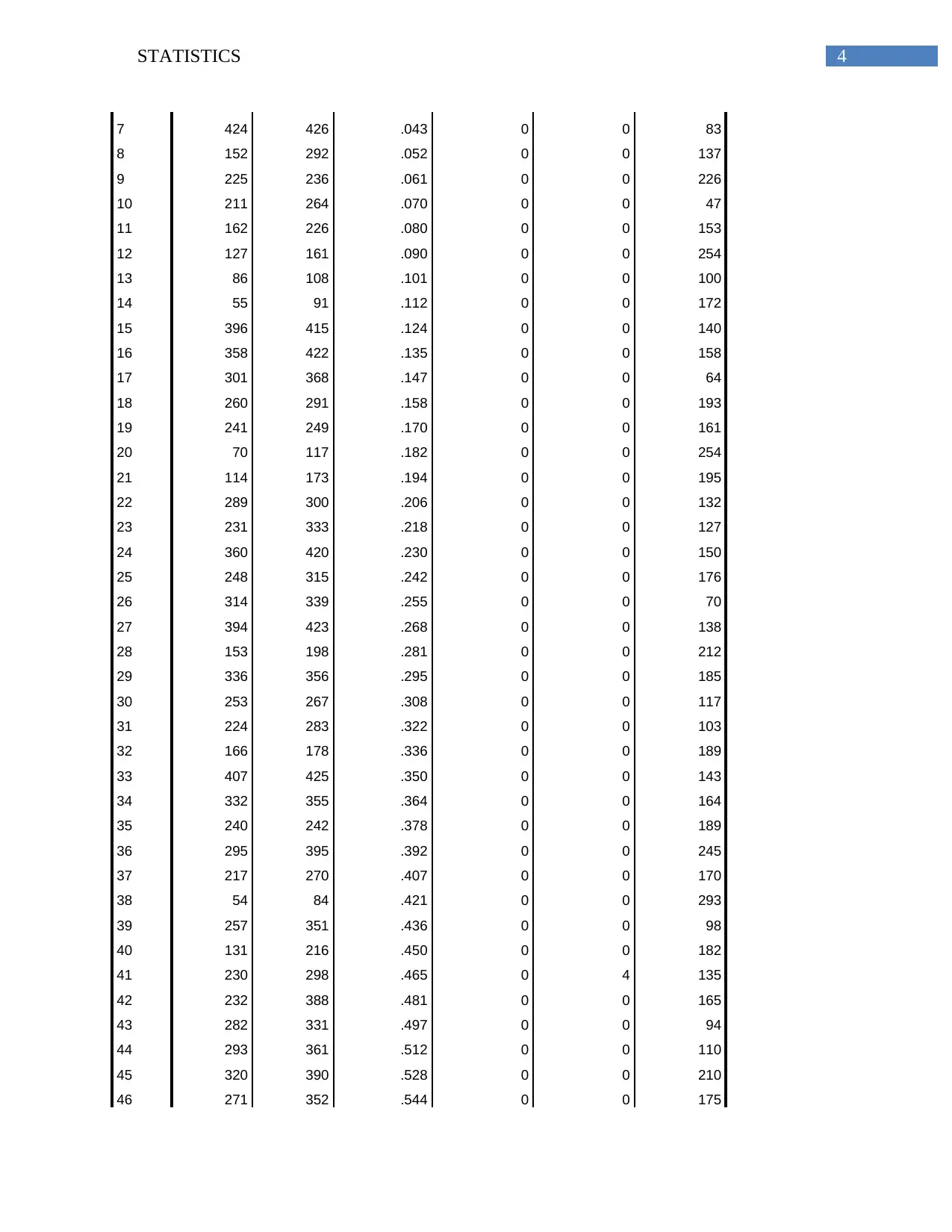
4STATISTICS
7 424 426 .043 0 0 83
8 152 292 .052 0 0 137
9 225 236 .061 0 0 226
10 211 264 .070 0 0 47
11 162 226 .080 0 0 153
12 127 161 .090 0 0 254
13 86 108 .101 0 0 100
14 55 91 .112 0 0 172
15 396 415 .124 0 0 140
16 358 422 .135 0 0 158
17 301 368 .147 0 0 64
18 260 291 .158 0 0 193
19 241 249 .170 0 0 161
20 70 117 .182 0 0 254
21 114 173 .194 0 0 195
22 289 300 .206 0 0 132
23 231 333 .218 0 0 127
24 360 420 .230 0 0 150
25 248 315 .242 0 0 176
26 314 339 .255 0 0 70
27 394 423 .268 0 0 138
28 153 198 .281 0 0 212
29 336 356 .295 0 0 185
30 253 267 .308 0 0 117
31 224 283 .322 0 0 103
32 166 178 .336 0 0 189
33 407 425 .350 0 0 143
34 332 355 .364 0 0 164
35 240 242 .378 0 0 189
36 295 395 .392 0 0 245
37 217 270 .407 0 0 170
38 54 84 .421 0 0 293
39 257 351 .436 0 0 98
40 131 216 .450 0 0 182
41 230 298 .465 0 4 135
42 232 388 .481 0 0 165
43 282 331 .497 0 0 94
44 293 361 .512 0 0 110
45 320 390 .528 0 0 210
46 271 352 .544 0 0 175
7 424 426 .043 0 0 83
8 152 292 .052 0 0 137
9 225 236 .061 0 0 226
10 211 264 .070 0 0 47
11 162 226 .080 0 0 153
12 127 161 .090 0 0 254
13 86 108 .101 0 0 100
14 55 91 .112 0 0 172
15 396 415 .124 0 0 140
16 358 422 .135 0 0 158
17 301 368 .147 0 0 64
18 260 291 .158 0 0 193
19 241 249 .170 0 0 161
20 70 117 .182 0 0 254
21 114 173 .194 0 0 195
22 289 300 .206 0 0 132
23 231 333 .218 0 0 127
24 360 420 .230 0 0 150
25 248 315 .242 0 0 176
26 314 339 .255 0 0 70
27 394 423 .268 0 0 138
28 153 198 .281 0 0 212
29 336 356 .295 0 0 185
30 253 267 .308 0 0 117
31 224 283 .322 0 0 103
32 166 178 .336 0 0 189
33 407 425 .350 0 0 143
34 332 355 .364 0 0 164
35 240 242 .378 0 0 189
36 295 395 .392 0 0 245
37 217 270 .407 0 0 170
38 54 84 .421 0 0 293
39 257 351 .436 0 0 98
40 131 216 .450 0 0 182
41 230 298 .465 0 4 135
42 232 388 .481 0 0 165
43 282 331 .497 0 0 94
44 293 361 .512 0 0 110
45 320 390 .528 0 0 210
46 271 352 .544 0 0 175
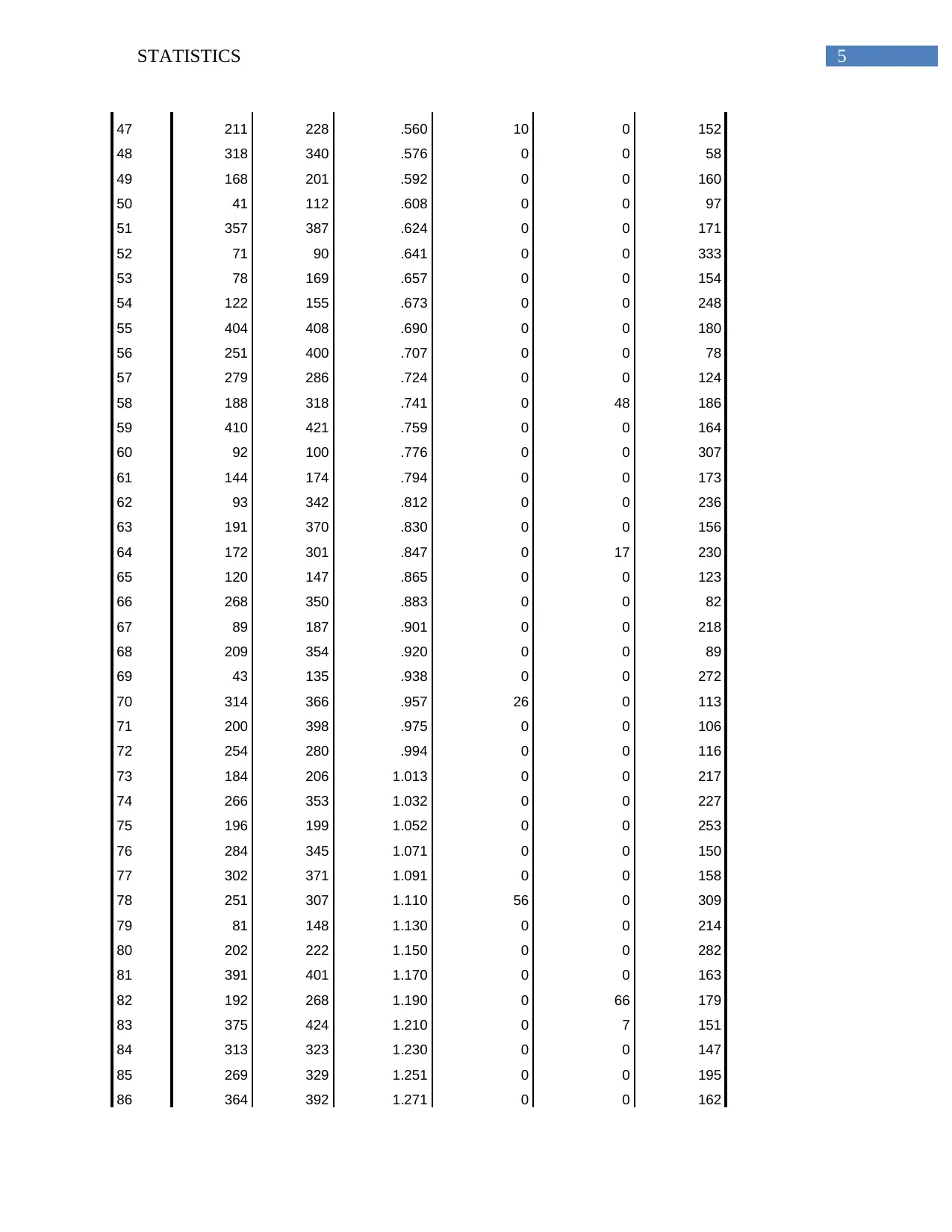
5STATISTICS
47 211 228 .560 10 0 152
48 318 340 .576 0 0 58
49 168 201 .592 0 0 160
50 41 112 .608 0 0 97
51 357 387 .624 0 0 171
52 71 90 .641 0 0 333
53 78 169 .657 0 0 154
54 122 155 .673 0 0 248
55 404 408 .690 0 0 180
56 251 400 .707 0 0 78
57 279 286 .724 0 0 124
58 188 318 .741 0 48 186
59 410 421 .759 0 0 164
60 92 100 .776 0 0 307
61 144 174 .794 0 0 173
62 93 342 .812 0 0 236
63 191 370 .830 0 0 156
64 172 301 .847 0 17 230
65 120 147 .865 0 0 123
66 268 350 .883 0 0 82
67 89 187 .901 0 0 218
68 209 354 .920 0 0 89
69 43 135 .938 0 0 272
70 314 366 .957 26 0 113
71 200 398 .975 0 0 106
72 254 280 .994 0 0 116
73 184 206 1.013 0 0 217
74 266 353 1.032 0 0 227
75 196 199 1.052 0 0 253
76 284 345 1.071 0 0 150
77 302 371 1.091 0 0 158
78 251 307 1.110 56 0 309
79 81 148 1.130 0 0 214
80 202 222 1.150 0 0 282
81 391 401 1.170 0 0 163
82 192 268 1.190 0 66 179
83 375 424 1.210 0 7 151
84 313 323 1.230 0 0 147
85 269 329 1.251 0 0 195
86 364 392 1.271 0 0 162
47 211 228 .560 10 0 152
48 318 340 .576 0 0 58
49 168 201 .592 0 0 160
50 41 112 .608 0 0 97
51 357 387 .624 0 0 171
52 71 90 .641 0 0 333
53 78 169 .657 0 0 154
54 122 155 .673 0 0 248
55 404 408 .690 0 0 180
56 251 400 .707 0 0 78
57 279 286 .724 0 0 124
58 188 318 .741 0 48 186
59 410 421 .759 0 0 164
60 92 100 .776 0 0 307
61 144 174 .794 0 0 173
62 93 342 .812 0 0 236
63 191 370 .830 0 0 156
64 172 301 .847 0 17 230
65 120 147 .865 0 0 123
66 268 350 .883 0 0 82
67 89 187 .901 0 0 218
68 209 354 .920 0 0 89
69 43 135 .938 0 0 272
70 314 366 .957 26 0 113
71 200 398 .975 0 0 106
72 254 280 .994 0 0 116
73 184 206 1.013 0 0 217
74 266 353 1.032 0 0 227
75 196 199 1.052 0 0 253
76 284 345 1.071 0 0 150
77 302 371 1.091 0 0 158
78 251 307 1.110 56 0 309
79 81 148 1.130 0 0 214
80 202 222 1.150 0 0 282
81 391 401 1.170 0 0 163
82 192 268 1.190 0 66 179
83 375 424 1.210 0 7 151
84 313 323 1.230 0 0 147
85 269 329 1.251 0 0 195
86 364 392 1.271 0 0 162
⊘ This is a preview!⊘
Do you want full access?
Subscribe today to unlock all pages.

Trusted by 1+ million students worldwide

6STATISTICS
87 179 372 1.292 0 0 178
88 156 259 1.313 0 0 222
89 209 325 1.334 68 0 125
90 101 159 1.356 0 0 276
91 413 414 1.377 0 0 198
92 235 297 1.398 0 0 216
93 326 389 1.420 0 0 243
94 282 287 1.442 43 0 237
95 204 263 1.464 0 0 269
96 26 99 1.486 0 0 209
97 41 67 1.508 50 0 284
98 257 321 1.530 39 0 272
99 116 243 1.553 0 0 215
100 33 86 1.575 0 13 177
101 139 376 1.598 0 0 190
102 111 233 1.620 0 0 115
103 224 365 1.643 31 0 285
104 195 239 1.666 0 0 221
105 163 310 1.689 0 0 251
106 200 244 1.712 71 0 218
107 37 61 1.736 0 0 321
108 214 285 1.759 0 0 239
109 15 29 1.783 0 0 262
110 293 341 1.807 44 3 187
111 124 337 1.830 0 0 224
112 319 347 1.854 0 0 290
113 299 314 1.878 0 70 293
114 303 379 1.903 0 0 225
115 111 277 1.927 102 0 296
116 223 254 1.952 0 72 230
117 208 253 1.977 0 30 217
118 290 308 2.002 0 0 198
119 203 218 2.027 0 0 191
120 219 272 2.053 0 0 133
121 369 412 2.078 0 0 192
122 250 418 2.104 0 0 276
123 120 129 2.131 65 0 277
124 276 279 2.158 0 57 156
125 209 338 2.184 89 0 258
126 363 382 2.212 0 0 256
87 179 372 1.292 0 0 178
88 156 259 1.313 0 0 222
89 209 325 1.334 68 0 125
90 101 159 1.356 0 0 276
91 413 414 1.377 0 0 198
92 235 297 1.398 0 0 216
93 326 389 1.420 0 0 243
94 282 287 1.442 43 0 237
95 204 263 1.464 0 0 269
96 26 99 1.486 0 0 209
97 41 67 1.508 50 0 284
98 257 321 1.530 39 0 272
99 116 243 1.553 0 0 215
100 33 86 1.575 0 13 177
101 139 376 1.598 0 0 190
102 111 233 1.620 0 0 115
103 224 365 1.643 31 0 285
104 195 239 1.666 0 0 221
105 163 310 1.689 0 0 251
106 200 244 1.712 71 0 218
107 37 61 1.736 0 0 321
108 214 285 1.759 0 0 239
109 15 29 1.783 0 0 262
110 293 341 1.807 44 3 187
111 124 337 1.830 0 0 224
112 319 347 1.854 0 0 290
113 299 314 1.878 0 70 293
114 303 379 1.903 0 0 225
115 111 277 1.927 102 0 296
116 223 254 1.952 0 72 230
117 208 253 1.977 0 30 217
118 290 308 2.002 0 0 198
119 203 218 2.027 0 0 191
120 219 272 2.053 0 0 133
121 369 412 2.078 0 0 192
122 250 418 2.104 0 0 276
123 120 129 2.131 65 0 277
124 276 279 2.158 0 57 156
125 209 338 2.184 89 0 258
126 363 382 2.212 0 0 256
Paraphrase This Document
Need a fresh take? Get an instant paraphrase of this document with our AI Paraphraser
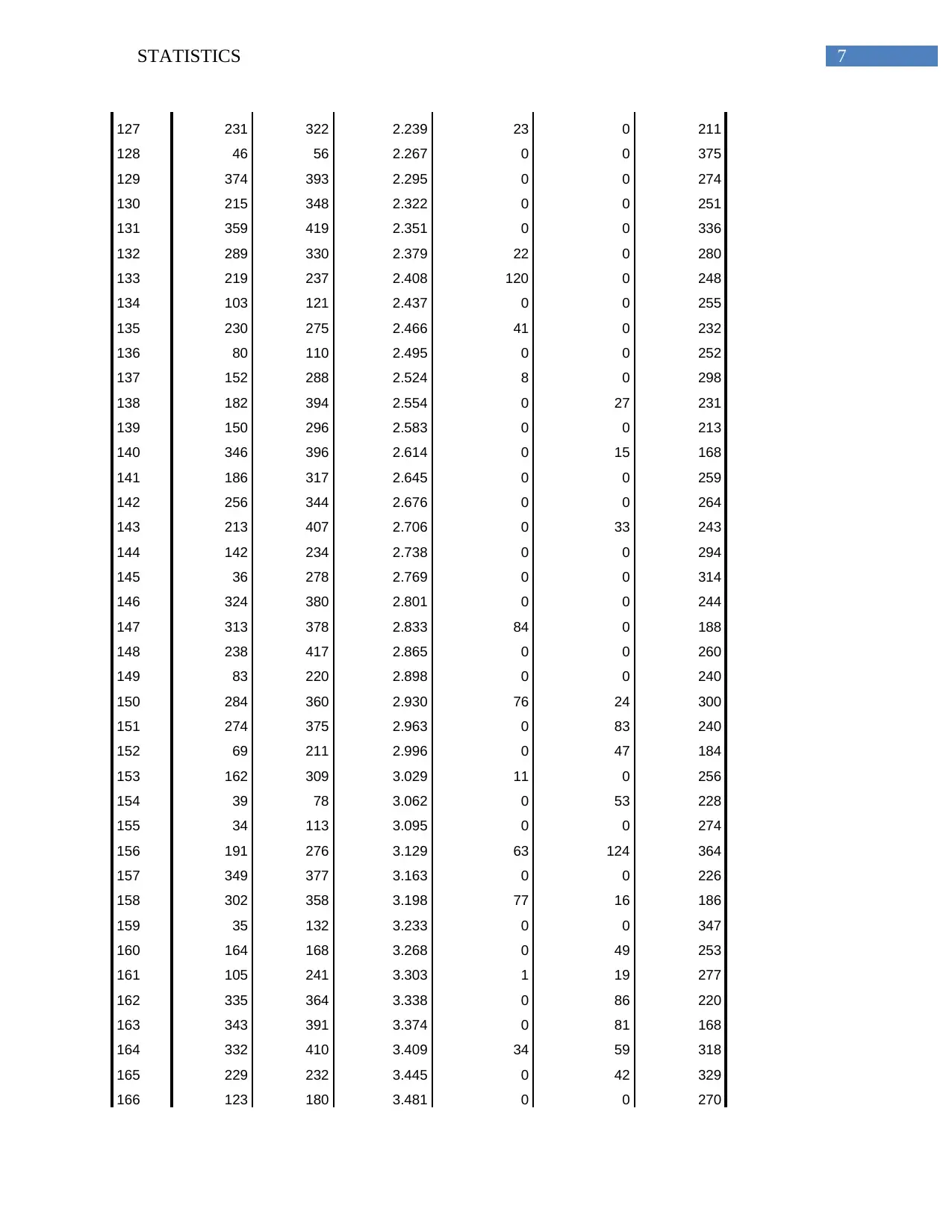
7STATISTICS
127 231 322 2.239 23 0 211
128 46 56 2.267 0 0 375
129 374 393 2.295 0 0 274
130 215 348 2.322 0 0 251
131 359 419 2.351 0 0 336
132 289 330 2.379 22 0 280
133 219 237 2.408 120 0 248
134 103 121 2.437 0 0 255
135 230 275 2.466 41 0 232
136 80 110 2.495 0 0 252
137 152 288 2.524 8 0 298
138 182 394 2.554 0 27 231
139 150 296 2.583 0 0 213
140 346 396 2.614 0 15 168
141 186 317 2.645 0 0 259
142 256 344 2.676 0 0 264
143 213 407 2.706 0 33 243
144 142 234 2.738 0 0 294
145 36 278 2.769 0 0 314
146 324 380 2.801 0 0 244
147 313 378 2.833 84 0 188
148 238 417 2.865 0 0 260
149 83 220 2.898 0 0 240
150 284 360 2.930 76 24 300
151 274 375 2.963 0 83 240
152 69 211 2.996 0 47 184
153 162 309 3.029 11 0 256
154 39 78 3.062 0 53 228
155 34 113 3.095 0 0 274
156 191 276 3.129 63 124 364
157 349 377 3.163 0 0 226
158 302 358 3.198 77 16 186
159 35 132 3.233 0 0 347
160 164 168 3.268 0 49 253
161 105 241 3.303 1 19 277
162 335 364 3.338 0 86 220
163 343 391 3.374 0 81 168
164 332 410 3.409 34 59 318
165 229 232 3.445 0 42 329
166 123 180 3.481 0 0 270
127 231 322 2.239 23 0 211
128 46 56 2.267 0 0 375
129 374 393 2.295 0 0 274
130 215 348 2.322 0 0 251
131 359 419 2.351 0 0 336
132 289 330 2.379 22 0 280
133 219 237 2.408 120 0 248
134 103 121 2.437 0 0 255
135 230 275 2.466 41 0 232
136 80 110 2.495 0 0 252
137 152 288 2.524 8 0 298
138 182 394 2.554 0 27 231
139 150 296 2.583 0 0 213
140 346 396 2.614 0 15 168
141 186 317 2.645 0 0 259
142 256 344 2.676 0 0 264
143 213 407 2.706 0 33 243
144 142 234 2.738 0 0 294
145 36 278 2.769 0 0 314
146 324 380 2.801 0 0 244
147 313 378 2.833 84 0 188
148 238 417 2.865 0 0 260
149 83 220 2.898 0 0 240
150 284 360 2.930 76 24 300
151 274 375 2.963 0 83 240
152 69 211 2.996 0 47 184
153 162 309 3.029 11 0 256
154 39 78 3.062 0 53 228
155 34 113 3.095 0 0 274
156 191 276 3.129 63 124 364
157 349 377 3.163 0 0 226
158 302 358 3.198 77 16 186
159 35 132 3.233 0 0 347
160 164 168 3.268 0 49 253
161 105 241 3.303 1 19 277
162 335 364 3.338 0 86 220
163 343 391 3.374 0 81 168
164 332 410 3.409 34 59 318
165 229 232 3.445 0 42 329
166 123 180 3.481 0 0 270
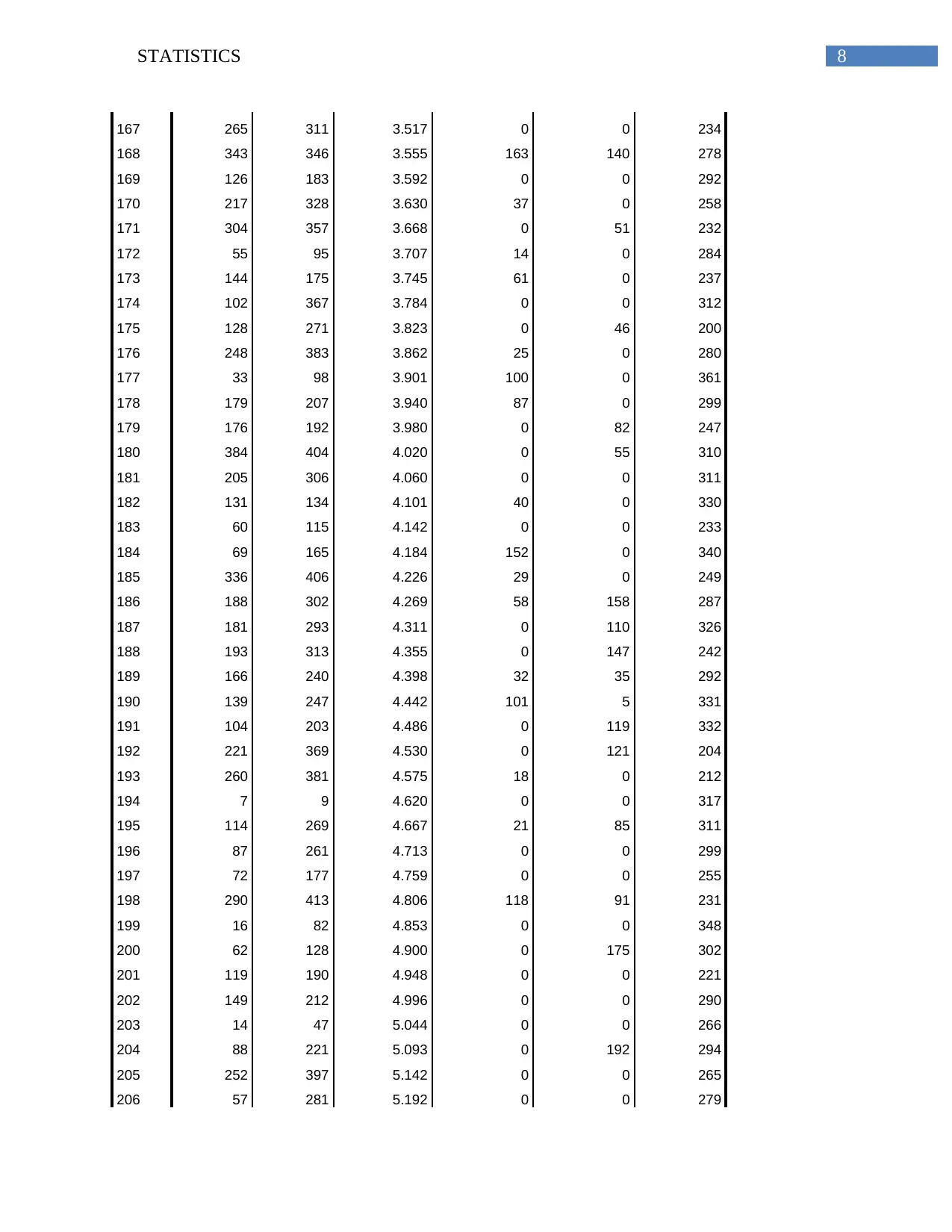
8STATISTICS
167 265 311 3.517 0 0 234
168 343 346 3.555 163 140 278
169 126 183 3.592 0 0 292
170 217 328 3.630 37 0 258
171 304 357 3.668 0 51 232
172 55 95 3.707 14 0 284
173 144 175 3.745 61 0 237
174 102 367 3.784 0 0 312
175 128 271 3.823 0 46 200
176 248 383 3.862 25 0 280
177 33 98 3.901 100 0 361
178 179 207 3.940 87 0 299
179 176 192 3.980 0 82 247
180 384 404 4.020 0 55 310
181 205 306 4.060 0 0 311
182 131 134 4.101 40 0 330
183 60 115 4.142 0 0 233
184 69 165 4.184 152 0 340
185 336 406 4.226 29 0 249
186 188 302 4.269 58 158 287
187 181 293 4.311 0 110 326
188 193 313 4.355 0 147 242
189 166 240 4.398 32 35 292
190 139 247 4.442 101 5 331
191 104 203 4.486 0 119 332
192 221 369 4.530 0 121 204
193 260 381 4.575 18 0 212
194 7 9 4.620 0 0 317
195 114 269 4.667 21 85 311
196 87 261 4.713 0 0 299
197 72 177 4.759 0 0 255
198 290 413 4.806 118 91 231
199 16 82 4.853 0 0 348
200 62 128 4.900 0 175 302
201 119 190 4.948 0 0 221
202 149 212 4.996 0 0 290
203 14 47 5.044 0 0 266
204 88 221 5.093 0 192 294
205 252 397 5.142 0 0 265
206 57 281 5.192 0 0 279
167 265 311 3.517 0 0 234
168 343 346 3.555 163 140 278
169 126 183 3.592 0 0 292
170 217 328 3.630 37 0 258
171 304 357 3.668 0 51 232
172 55 95 3.707 14 0 284
173 144 175 3.745 61 0 237
174 102 367 3.784 0 0 312
175 128 271 3.823 0 46 200
176 248 383 3.862 25 0 280
177 33 98 3.901 100 0 361
178 179 207 3.940 87 0 299
179 176 192 3.980 0 82 247
180 384 404 4.020 0 55 310
181 205 306 4.060 0 0 311
182 131 134 4.101 40 0 330
183 60 115 4.142 0 0 233
184 69 165 4.184 152 0 340
185 336 406 4.226 29 0 249
186 188 302 4.269 58 158 287
187 181 293 4.311 0 110 326
188 193 313 4.355 0 147 242
189 166 240 4.398 32 35 292
190 139 247 4.442 101 5 331
191 104 203 4.486 0 119 332
192 221 369 4.530 0 121 204
193 260 381 4.575 18 0 212
194 7 9 4.620 0 0 317
195 114 269 4.667 21 85 311
196 87 261 4.713 0 0 299
197 72 177 4.759 0 0 255
198 290 413 4.806 118 91 231
199 16 82 4.853 0 0 348
200 62 128 4.900 0 175 302
201 119 190 4.948 0 0 221
202 149 212 4.996 0 0 290
203 14 47 5.044 0 0 266
204 88 221 5.093 0 192 294
205 252 397 5.142 0 0 265
206 57 281 5.192 0 0 279
⊘ This is a preview!⊘
Do you want full access?
Subscribe today to unlock all pages.

Trusted by 1+ million students worldwide
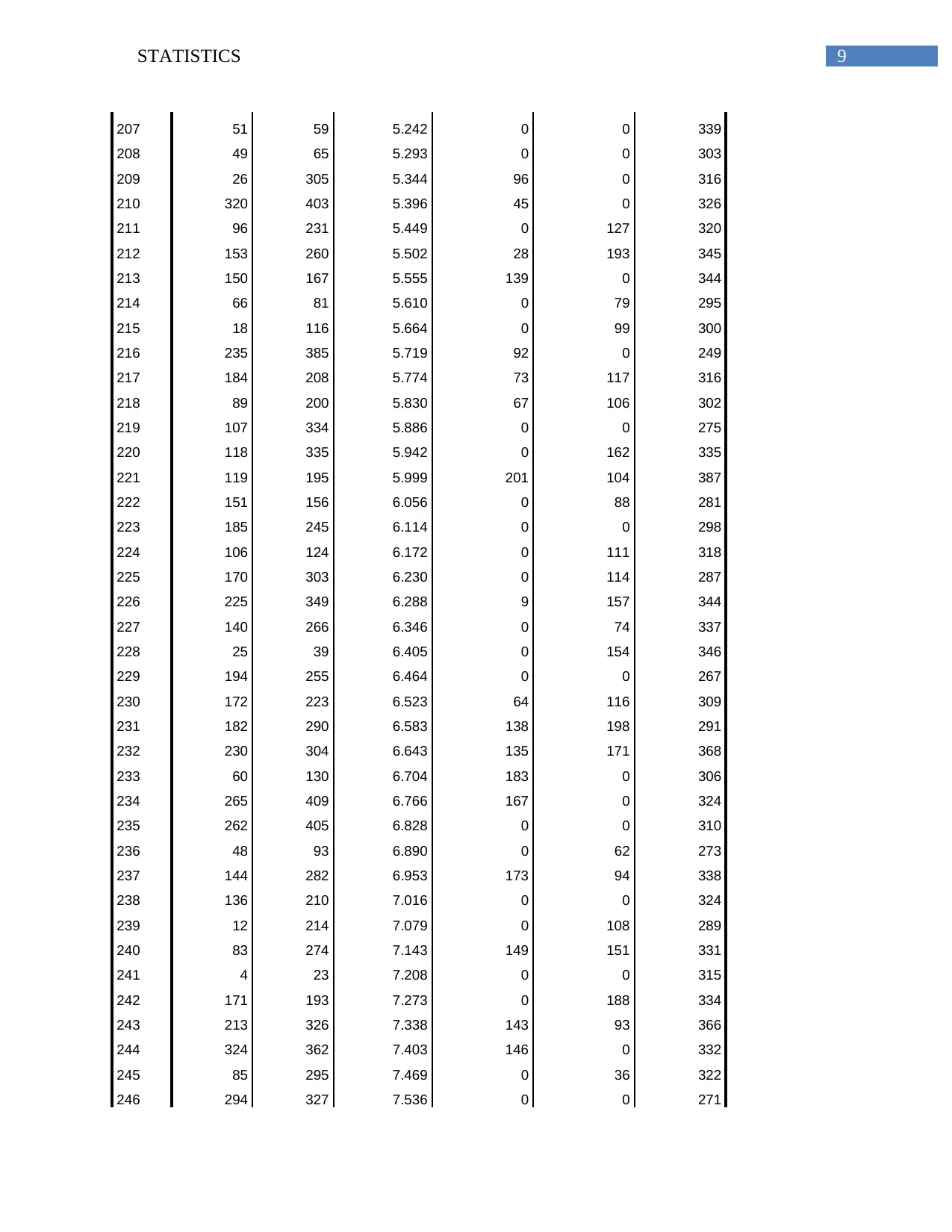
9STATISTICS
207 51 59 5.242 0 0 339
208 49 65 5.293 0 0 303
209 26 305 5.344 96 0 316
210 320 403 5.396 45 0 326
211 96 231 5.449 0 127 320
212 153 260 5.502 28 193 345
213 150 167 5.555 139 0 344
214 66 81 5.610 0 79 295
215 18 116 5.664 0 99 300
216 235 385 5.719 92 0 249
217 184 208 5.774 73 117 316
218 89 200 5.830 67 106 302
219 107 334 5.886 0 0 275
220 118 335 5.942 0 162 335
221 119 195 5.999 201 104 387
222 151 156 6.056 0 88 281
223 185 245 6.114 0 0 298
224 106 124 6.172 0 111 318
225 170 303 6.230 0 114 287
226 225 349 6.288 9 157 344
227 140 266 6.346 0 74 337
228 25 39 6.405 0 154 346
229 194 255 6.464 0 0 267
230 172 223 6.523 64 116 309
231 182 290 6.583 138 198 291
232 230 304 6.643 135 171 368
233 60 130 6.704 183 0 306
234 265 409 6.766 167 0 324
235 262 405 6.828 0 0 310
236 48 93 6.890 0 62 273
237 144 282 6.953 173 94 338
238 136 210 7.016 0 0 324
239 12 214 7.079 0 108 289
240 83 274 7.143 149 151 331
241 4 23 7.208 0 0 315
242 171 193 7.273 0 188 334
243 213 326 7.338 143 93 366
244 324 362 7.403 146 0 332
245 85 295 7.469 0 36 322
246 294 327 7.536 0 0 271
207 51 59 5.242 0 0 339
208 49 65 5.293 0 0 303
209 26 305 5.344 96 0 316
210 320 403 5.396 45 0 326
211 96 231 5.449 0 127 320
212 153 260 5.502 28 193 345
213 150 167 5.555 139 0 344
214 66 81 5.610 0 79 295
215 18 116 5.664 0 99 300
216 235 385 5.719 92 0 249
217 184 208 5.774 73 117 316
218 89 200 5.830 67 106 302
219 107 334 5.886 0 0 275
220 118 335 5.942 0 162 335
221 119 195 5.999 201 104 387
222 151 156 6.056 0 88 281
223 185 245 6.114 0 0 298
224 106 124 6.172 0 111 318
225 170 303 6.230 0 114 287
226 225 349 6.288 9 157 344
227 140 266 6.346 0 74 337
228 25 39 6.405 0 154 346
229 194 255 6.464 0 0 267
230 172 223 6.523 64 116 309
231 182 290 6.583 138 198 291
232 230 304 6.643 135 171 368
233 60 130 6.704 183 0 306
234 265 409 6.766 167 0 324
235 262 405 6.828 0 0 310
236 48 93 6.890 0 62 273
237 144 282 6.953 173 94 338
238 136 210 7.016 0 0 324
239 12 214 7.079 0 108 289
240 83 274 7.143 149 151 331
241 4 23 7.208 0 0 315
242 171 193 7.273 0 188 334
243 213 326 7.338 143 93 366
244 324 362 7.403 146 0 332
245 85 295 7.469 0 36 322
246 294 327 7.536 0 0 271
Paraphrase This Document
Need a fresh take? Get an instant paraphrase of this document with our AI Paraphraser

10STATISTICS
247 146 176 7.602 0 179 369
248 122 219 7.669 54 133 312
249 235 336 7.738 216 185 329
250 189 258 7.806 0 0 285
251 163 215 7.876 105 130 308
252 52 80 7.946 0 136 350
253 164 196 8.017 160 75 333
254 70 127 8.088 20 12 340
255 72 103 8.161 197 134 307
256 162 363 8.234 153 126 355
257 42 273 8.308 0 0 362
258 209 217 8.382 125 170 349
259 125 186 8.456 0 141 351
260 138 238 8.531 0 148 353
261 24 27 8.606 0 0 342
262 15 77 8.681 109 0 321
263 64 158 8.758 0 0 286
264 74 256 8.834 0 142 354
265 252 411 8.914 205 0 365
266 14 19 8.994 203 0 348
267 75 194 9.076 0 229 336
268 28 157 9.158 0 0 288
269 204 227 9.241 95 0 314
270 45 123 9.325 0 166 306
271 294 386 9.410 246 0 354
272 43 257 9.496 69 98 322
273 44 48 9.582 0 236 338
274 34 374 9.669 155 129 341
275 97 107 9.756 0 219 327
276 101 250 9.844 90 122 305
277 105 120 9.934 161 123 343
278 154 343 10.024 2 168 372
279 57 68 10.114 206 0 320
280 248 289 10.206 176 132 341
281 151 316 10.299 222 0 379
282 143 202 10.392 0 80 313
283 21 145 10.485 0 6 362
284 41 55 10.579 97 172 345
285 189 224 10.674 250 103 366
286 31 64 10.772 0 263 327
247 146 176 7.602 0 179 369
248 122 219 7.669 54 133 312
249 235 336 7.738 216 185 329
250 189 258 7.806 0 0 285
251 163 215 7.876 105 130 308
252 52 80 7.946 0 136 350
253 164 196 8.017 160 75 333
254 70 127 8.088 20 12 340
255 72 103 8.161 197 134 307
256 162 363 8.234 153 126 355
257 42 273 8.308 0 0 362
258 209 217 8.382 125 170 349
259 125 186 8.456 0 141 351
260 138 238 8.531 0 148 353
261 24 27 8.606 0 0 342
262 15 77 8.681 109 0 321
263 64 158 8.758 0 0 286
264 74 256 8.834 0 142 354
265 252 411 8.914 205 0 365
266 14 19 8.994 203 0 348
267 75 194 9.076 0 229 336
268 28 157 9.158 0 0 288
269 204 227 9.241 95 0 314
270 45 123 9.325 0 166 306
271 294 386 9.410 246 0 354
272 43 257 9.496 69 98 322
273 44 48 9.582 0 236 338
274 34 374 9.669 155 129 341
275 97 107 9.756 0 219 327
276 101 250 9.844 90 122 305
277 105 120 9.934 161 123 343
278 154 343 10.024 2 168 372
279 57 68 10.114 206 0 320
280 248 289 10.206 176 132 341
281 151 316 10.299 222 0 379
282 143 202 10.392 0 80 313
283 21 145 10.485 0 6 362
284 41 55 10.579 97 172 345
285 189 224 10.674 250 103 366
286 31 64 10.772 0 263 327
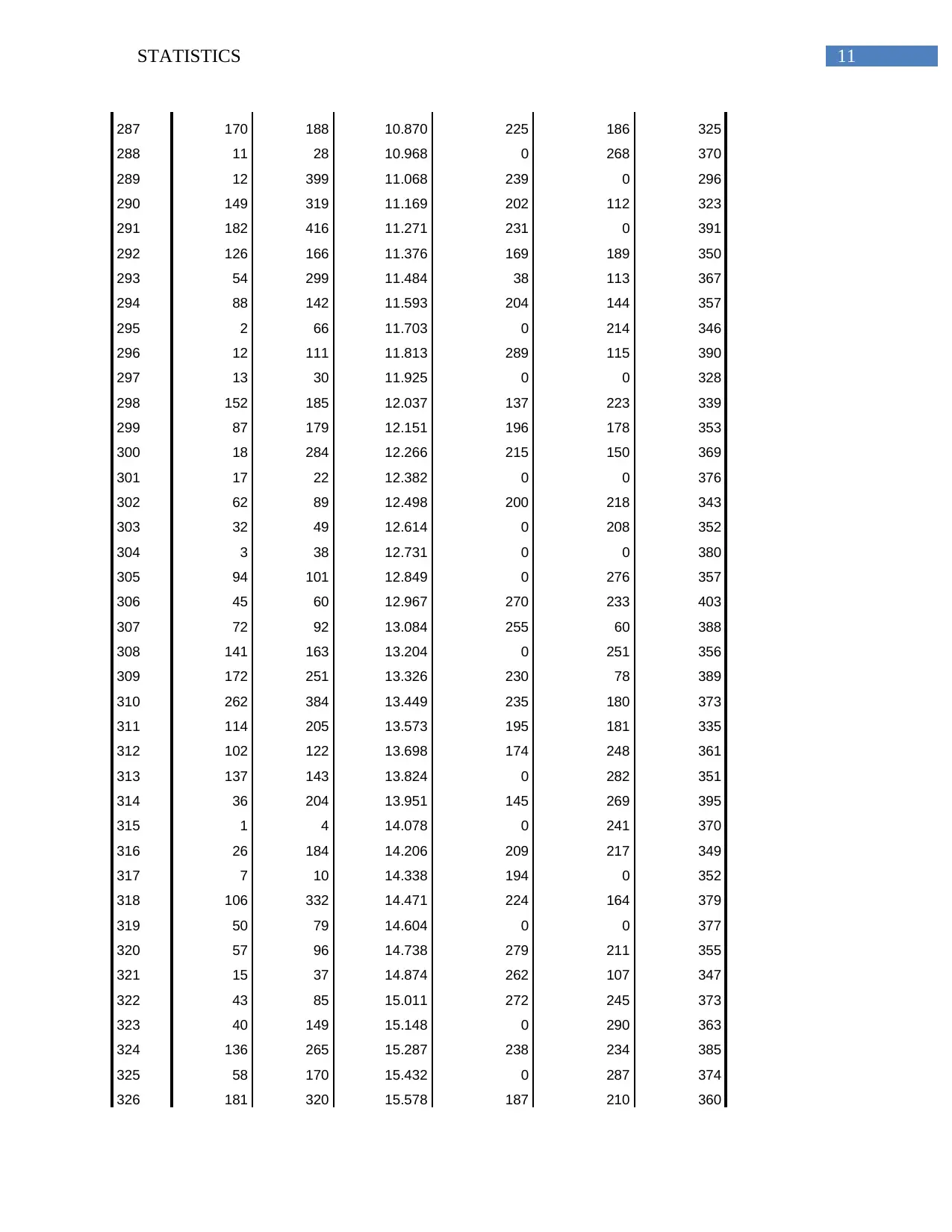
11STATISTICS
287 170 188 10.870 225 186 325
288 11 28 10.968 0 268 370
289 12 399 11.068 239 0 296
290 149 319 11.169 202 112 323
291 182 416 11.271 231 0 391
292 126 166 11.376 169 189 350
293 54 299 11.484 38 113 367
294 88 142 11.593 204 144 357
295 2 66 11.703 0 214 346
296 12 111 11.813 289 115 390
297 13 30 11.925 0 0 328
298 152 185 12.037 137 223 339
299 87 179 12.151 196 178 353
300 18 284 12.266 215 150 369
301 17 22 12.382 0 0 376
302 62 89 12.498 200 218 343
303 32 49 12.614 0 208 352
304 3 38 12.731 0 0 380
305 94 101 12.849 0 276 357
306 45 60 12.967 270 233 403
307 72 92 13.084 255 60 388
308 141 163 13.204 0 251 356
309 172 251 13.326 230 78 389
310 262 384 13.449 235 180 373
311 114 205 13.573 195 181 335
312 102 122 13.698 174 248 361
313 137 143 13.824 0 282 351
314 36 204 13.951 145 269 395
315 1 4 14.078 0 241 370
316 26 184 14.206 209 217 349
317 7 10 14.338 194 0 352
318 106 332 14.471 224 164 379
319 50 79 14.604 0 0 377
320 57 96 14.738 279 211 355
321 15 37 14.874 262 107 347
322 43 85 15.011 272 245 373
323 40 149 15.148 0 290 363
324 136 265 15.287 238 234 385
325 58 170 15.432 0 287 374
326 181 320 15.578 187 210 360
287 170 188 10.870 225 186 325
288 11 28 10.968 0 268 370
289 12 399 11.068 239 0 296
290 149 319 11.169 202 112 323
291 182 416 11.271 231 0 391
292 126 166 11.376 169 189 350
293 54 299 11.484 38 113 367
294 88 142 11.593 204 144 357
295 2 66 11.703 0 214 346
296 12 111 11.813 289 115 390
297 13 30 11.925 0 0 328
298 152 185 12.037 137 223 339
299 87 179 12.151 196 178 353
300 18 284 12.266 215 150 369
301 17 22 12.382 0 0 376
302 62 89 12.498 200 218 343
303 32 49 12.614 0 208 352
304 3 38 12.731 0 0 380
305 94 101 12.849 0 276 357
306 45 60 12.967 270 233 403
307 72 92 13.084 255 60 388
308 141 163 13.204 0 251 356
309 172 251 13.326 230 78 389
310 262 384 13.449 235 180 373
311 114 205 13.573 195 181 335
312 102 122 13.698 174 248 361
313 137 143 13.824 0 282 351
314 36 204 13.951 145 269 395
315 1 4 14.078 0 241 370
316 26 184 14.206 209 217 349
317 7 10 14.338 194 0 352
318 106 332 14.471 224 164 379
319 50 79 14.604 0 0 377
320 57 96 14.738 279 211 355
321 15 37 14.874 262 107 347
322 43 85 15.011 272 245 373
323 40 149 15.148 0 290 363
324 136 265 15.287 238 234 385
325 58 170 15.432 0 287 374
326 181 320 15.578 187 210 360
⊘ This is a preview!⊘
Do you want full access?
Subscribe today to unlock all pages.

Trusted by 1+ million students worldwide
1 out of 54
Your All-in-One AI-Powered Toolkit for Academic Success.
+13062052269
info@desklib.com
Available 24*7 on WhatsApp / Email
![[object Object]](/_next/static/media/star-bottom.7253800d.svg)
Unlock your academic potential
Copyright © 2020–2026 A2Z Services. All Rights Reserved. Developed and managed by ZUCOL.